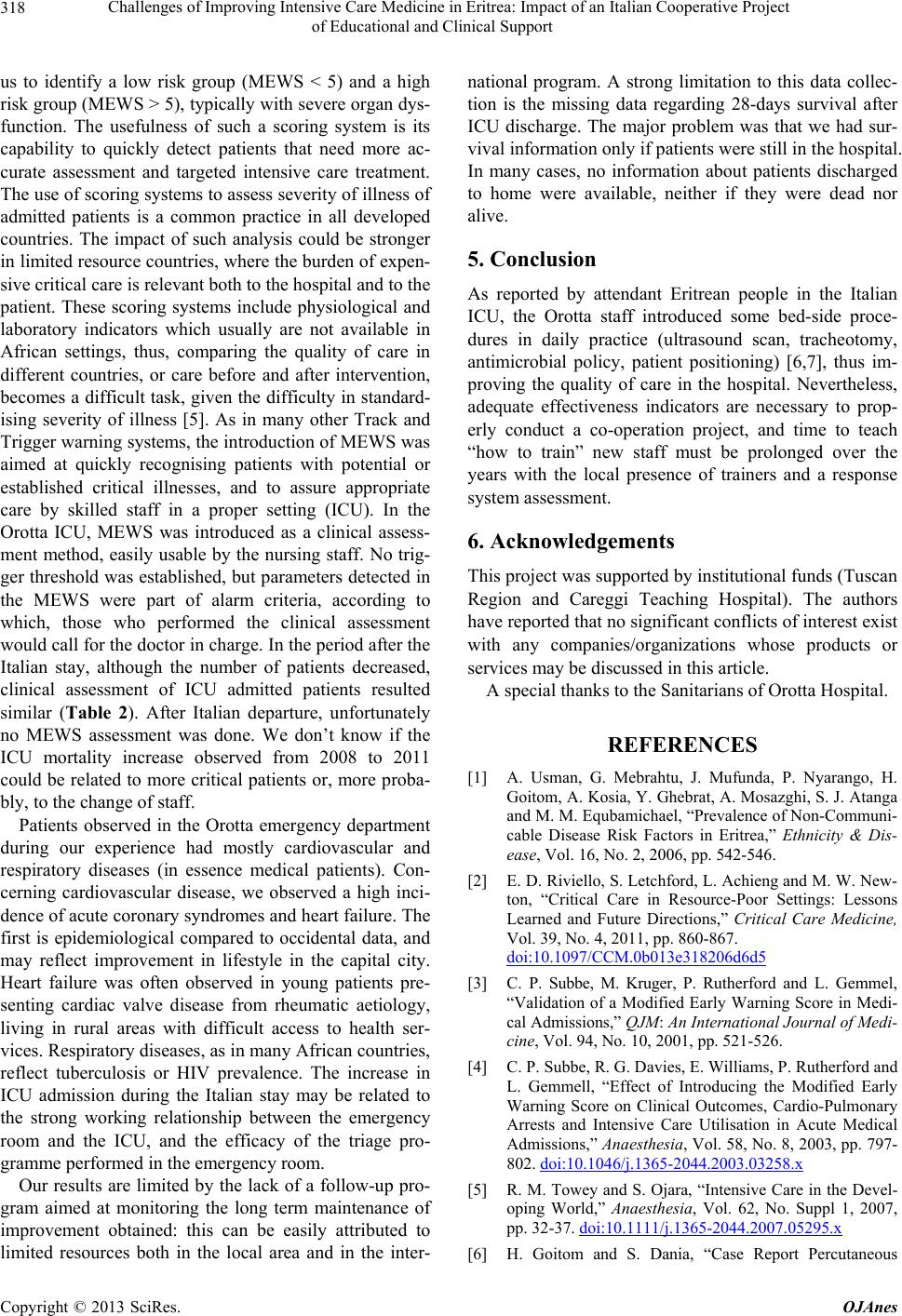
Challenges of Improving Intensive Care Medicine in Eritrea: Impact of an Italian Cooperative Project
of Educational and Clinical Support
318
us to identify a low risk group (MEWS < 5) and a high
risk group (MEWS > 5), typically with severe organ dys-
function. The usefulness of such a scoring system is its
capability to quickly detect patients that need more ac-
curate assessment and targeted intensive care treatment.
The use of scoring systems to assess severity of illness of
admitted patients is a common practice in all developed
countries. The impact of such analysis could be stronger
in limited resource countries, where the burden of expen-
sive critical care is relevant both to the hospital and to the
patient. These scoring systems include physiological and
laboratory indicators which usually are not available in
African settings, thus, comparing the quality of care in
different countries, or care before and after intervention,
becomes a difficult task, given the difficulty in standard-
ising severity of illness [5]. As in many other Track and
Trigger warning systems, the introduction of MEWS was
aimed at quickly recognising patients with potential or
established critical illnesses, and to assure appropriate
care by skilled staff in a proper setting (ICU). In the
Orotta ICU, MEWS was introduced as a clinical assess-
ment method, easily usable by the nursing staff. No trig-
ger threshold was established, but parameters detected in
the MEWS were part of alarm criteria, according to
which, those who performed the clinical assessment
would call for the doctor in charge. In the period after the
Italian stay, although the number of patients decreased,
clinical assessment of ICU admitted patients resulted
similar (Table 2). After Italian departure, unfortunately
no MEWS assessment was done. We don’t know if the
ICU mortality increase observed from 2008 to 2011
could be related to more critical patients or, more proba-
bly, to the change of staff.
Patients observed in the Orotta emergency department
during our experience had mostly cardiovascular and
respiratory diseases (in essence medical patients). Con-
cerning cardiovascular disease, we observed a high inci-
dence of acute coronary syndromes and heart failure. The
first is epidemiological compared to occidental data, and
may reflect improvement in lifestyle in the capital city.
Heart failure was often observed in young patients pre-
senting cardiac valve disease from rheumatic aetiology,
living in rural areas with difficult access to health ser-
vices. Respiratory diseases, as in many African countries,
reflect tuberculosis or HIV prevalence. The increase in
ICU admission during the Italian stay may be related to
the strong working relationship between the emergency
room and the ICU, and the efficacy of the triage pro-
gramme performed in the emergency room.
Our results are limited by the lack of a follow-up pro-
gram aimed at monitoring the long term maintenance of
improvement obtained: this can be easily attributed to
limited resources both in the local area and in the inter-
national program. A strong limitation to this data collec-
tion is the missing data regarding 28-days survival after
ICU discharge. The major problem was that we had sur-
vival information only if patients were still in the hospital.
In many cases, no information about patients discharged
to home were available, neither if they were dead nor
alive.
5. Conclusion
As reported by attendant Eritrean people in the Italian
ICU, the Orotta staff introduced some bed-side proce-
dures in daily practice (ultrasound scan, tracheotomy,
antimicrobial policy, patient positioning) [6,7], thus im-
proving the quality of care in the hospital. Nevertheless,
adequate effectiveness indicators are necessary to prop-
erly conduct a co-operation project, and time to teach
“how to train” new staff must be prolonged over the
years with the local presence of trainers and a response
system assessment.
6. Acknowledgements
This project was supported by institutional funds (Tuscan
Region and Careggi Teaching Hospital). The authors
have reported that no significant conflicts of interest exist
with any companies/organizations whose products or
services may be discussed in this article.
A special thanks to the Sanitarians of Orotta Hospital.
REFERENCES
[1] A. Usman, G. Mebrahtu, J. Mufunda, P. Nyarango, H.
Goitom, A. Kosia, Y. Ghebrat, A. Mosazghi, S. J. Atanga
and M. M. Equbamichael, “Prevalence of Non-Communi-
cable Disease Risk Factors in Eritrea,” Ethnicity & Dis-
ease, Vol. 16, No. 2, 2006, pp. 542-546.
[2] E. D. Riviello, S. Letchford, L. Achieng and M. W. New-
ton, “Critical Care in Resource-Poor Settings: Lessons
Learned and Future Directions,” Critical Care Medicine,
Vol. 39, No. 4, 2011, pp. 860-867.
doi:10.1097/CCM.0b013e318206d6d5
[3] C. P. Subbe, M. Kruger, P. Rutherford and L. Gemmel,
“Validation of a Modified Early Warning Score in Medi-
cal Admissions,” QJM: An International Journal of Medi-
cine, Vol. 94, No. 10, 2001, pp. 521-526.
[4] C. P. Subbe, R. G. Davies, E. Williams, P. Rutherford and
L. Gemmell, “Effect of Introducing the Modified Early
Warning Score on Clinical Outcomes, Cardio-Pulmonary
Arrests and Intensive Care Utilisation in Acute Medical
Admissions,” Anaesthesia, Vol. 58, No. 8, 2003, pp. 797-
802. doi:10.1046/j.1365-2044.2003.03258.x
[5] R. M. Towey and S. Ojara, “Intensive Care in the Devel-
oping World,” Anaesthesia, Vol. 62, No. Suppl 1, 2007,
pp. 32-37. doi:10.1111/j.1365-2044.2007.05295.x
[6] H. Goitom and S. Dania, “Case Report Percutaneous
Copyright © 2013 SciRes. OJAnes